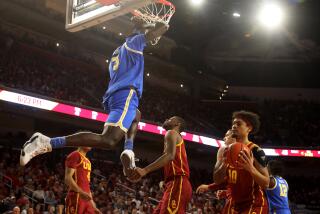Sisters Should Forgive, Forget
It is a tennis tournament of international stature now. There are few naysayers left.
The great players come not only because of rules and money, but because they want to. Sundayâs finals that matched Lindsay Davenport and Kim Clijsters, followed by Gustavo Kuerten and Lleyton Hewitt, would be any organizerâs dream.
The facility is world class, just as dreamer/tournament director Charlie Pasarell envisioned a few years ago, when he surprised people in tennis by announcing he was upgrading from his facility at the Hyatt Grand Champions. Most people thought that was tough to improve upon, but Pasarell did just that. By leaps and bounds.
People buy tickets, even with prices that prompt consideration of third mortgages. It is on peopleâs calendars, part of their entertainment budget. It is a nice place to be and to be seen, the latter always a factor in any Southern California sports attendance.
The most recent sponsor, Pacific Life, has stuck around for a few years and is starting to get the kind of mileage from its investment it expects. At least some people now think, and speak, of this as the Pacific Life Open, not the Indian Wells tennis tournament. And that becomes more the case the longer Pacific Life keeps writing big checks.
If you feel a âbutâ coming up here, you are right.
But the Williams sisters arenât here.
Again. With no change of heart in sight.
So does that make this a tennis tournament of international stature, but with an asterisk?
At the moment, yes.
Hereâs a review of why the Williamses -- the biggest names, draws, stars, attractions, symbols of the current game -- are not here, nor were here last year:
Venus defaulted to Serena literally minutes before their semifinal match two years ago. That was back when any match between them was a huge attraction for a number of reasons, including that they were terrific players. But there was also the element of intrigue over how hard they really played against each other. Was there some arranging before the match for one or the other to win? Were some wins by one or the other timed to benefit an upcoming shoe deal, or to benefit oneâs ranking when the other wasnât in as much need of points? Or did they just decide to take turns.
Since then, of course, they have played good matches in the finals of the last four Grand Slam events -- Serena winning all -- and the theory of tanked matches seems old hat.
But flash back to Indian Wells 2001 and things werenât quite so clear. When it was perceived that Venus had merely stepped aside to get Serena into the final, a public that had spent lots of money to get into a packed stadium to watch the sisters play was angry.
And good for them. The public too often gets ripped off by cheap team management or under-performing athletes.
Venus didnât help things by grudgingly sauntering into a news conference to explain her tendinitis injury and acting like somebody who didnât really want to be bothered. Newspaper stories, one by yours truly, fanned the flames. Nor was ESPN all that quiet in its anger at being stiffed just minutes before telecast time, on a match it had promoted well. Matter of fact, the only people really taking the high road were the main people running this tournament, Pasarell, Raymond Moore, Steve Simon and Dede Felich.
But there was no stopping the avalanche. Serena walked onto the court with Clijsters and the boos rang down. Those who have watched tennis for years had never seen anything like it. Even when tennis fans dressed in $400 Fila warmup suits rioted during the 1996 Olympics in Atlanta because Andre Agassi had been moved to a side court for a doubles match, there was not as much emotional outpouring as there was in the Indian Wells Garden that day, amid the palm trees and opulence of the Southern California desert.
The booing continued through much of the first set, but Serena gathered herself, won the final two sets and the tournament, handled herself beautifully when handed the microphone afterward and walked out of the stadium, never to be seen again in these parts.
The issue became publicly racial the next week, when USA Today quoted Richard Williams, the girlsâ father, as saying that the ânâ word was used by people around him during the match. There is no way of verifying that, but Paul Netter, a member of The Times sports staff, who was there to watch and was sitting near Richard, said he never heard anything like that. Netter is black.
The issue was financial. People paid a lot of money to buy tickets and expected to see what they paid for -- Venus vs. Serena. And it was fair play. If there is reasonable perception that somebody is faking an injury, should not that behavior warrant some boos?
The perception that anything racial was going on is especially ironic, since the main driving force in this event, Pasarell, is not only a minority himself, but played tennis at UCLA with Arthur Ashe, shared the No. 1 spot on the team and was one of the people closest to Ashe to the day he died. There is no clearer symbol of equality in sports than Ashe and few more aware of that than Pasarell.
Make no mistake. The Williams sisters are still angry about what happened here. And make no mistake. The tournament organizers have made efforts to sit down and talk, to meet somewhere, anywhere.
Make no mistake about something else. This has gone on too long. And for a reason more significant than Venus and Serena -- or perhaps parents Richard and Oracene -- may be thinking about.
The reason isnât any cliche, like what they are doing is bad for tennis. Or that they owe Pasarell anything.
No, the key reason was pointed out early in this event, on one of those balmy afternoons with the sun warm and the sky blue and perhaps 3,000 people watching as a couple of world-class players went at it on the court below. Looking down on the scene was veteran writer Jerry Magee of the San Diego Union Tribune, who will be 75 next month and who has covered a great deal of tennis and clearly understands the American sports landscape.
âSo whatâs wrong with this picture?â Magee asked.
One quick perusal of the crowd brought the answer: Almost no black faces in the stands.
âWasnât like that when the Williams sister played here,â Magee said.
The ball bounces back to Venus and Serena, and to Richard and Oracene.
Is not part of what they are proudest of in their incredible success in womenâs tennis that the audience for a once mostly rich and white fan base has become more diverse?
Is it not still a priority, a goal, a source of incredible pride, to get some more black faces back in the seats everywhere they play, as well as in the desert?
Isnât that the best reason for the Williams sisters to get over it?
More to Read
Go beyond the scoreboard
Get the latest on L.A.'s teams in the daily Sports Report newsletter.
You may occasionally receive promotional content from the Los Angeles Times.











